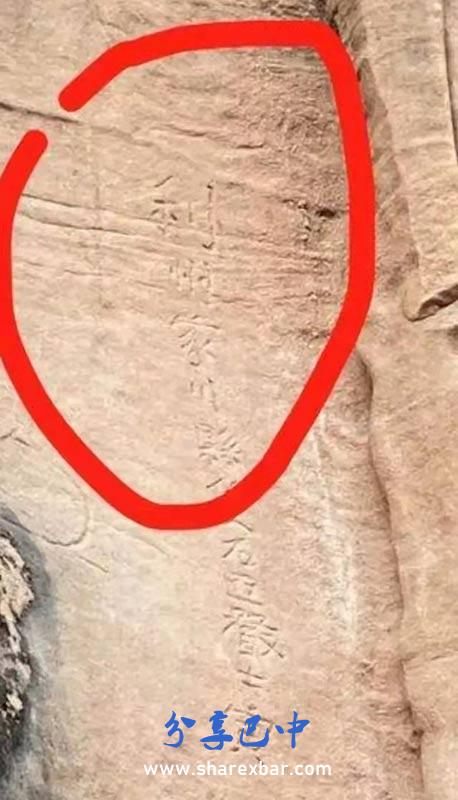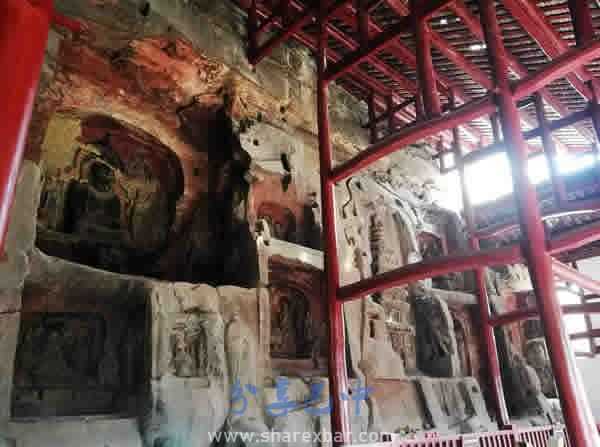
The poem says: Where can I find the queens hometown? I enter Wuling under the city of Shining.
According to the “Taiping Yulan,” it is recorded: “From Hanzhong to Shining City, entering Wuling, it twists and turns three times, resembling the character Ba, also known as the Ba River, passing through a steep gorge, called the Ba Gorge.” Wuling is the tomb of Wu Shiyue [yue], the father of Empress Dowager. Five miles west of Tongjiang City lies Thousand Buddha Cliff, formerly known as “Ba Wang Temple.” The “Tongjiang County Annals” states: “Ba Wang Temple has two paired halls facing each other in the temple courtyard.” Interestingly, this place was once mistakenly believed to be the tomb of Gan Ning, a general of Eastern Wu. According to the “Sichuan Tongzhi,” it is recorded: “Han Gan Nings tomb is located five miles west of the county, called Gan Valley. Ning was a general of Wu, and after his death, he was buried here.” Strangely, the Eastern Wu forces never reached Tongjiang, so how could Gan Ning have been “buried here” after his death?
After deliberation: Empress Wu Zetian was born in Bishan (Tongjiang) and spent her childhood in Lizhou (Guangyuan) and Jingzhou. At the age of ten, her father died while serving as the governor of Jingzhou, leaving her and her mother without support. They then returned to live at the temple in Bishan, where they buried her late father Wu Shiyue [yue] at todays Thousand Buddha Cliff. With the help of a merchant named Ma Mingfu who provided financial assistance, they were able to settle down. In the twelfth year of the Zhenguan era, General Shangguan Huairan of the Right Wu Hou defeated the Shanliao in Bishan when Wu Zetian was fourteen years old. She accompanied General Shangguan Huairan back to the capital, where Emperor Taizong, impressed by her beauty, selected her to serve as a concubine. After Emperor Taizongs death, she became a nun. During the Gaozong era, she returned to the palace and was enthroned as empress, gradually becoming involved in state affairs until she ascended the throne. After ascending the throne, Wu Zetian changed the name of Noshui County in Bishan to Jiaochuan County in Lizhou, renamed the temple in Bishan “Hong en Temple” (todays West Temple), and bestowed the name “Wuling” on Thousand Buddha Cliff, which later generations mistakenly believed to be the tomb of Gan Ning.
Lizhou Jiaochuan County Tangxian Township is where the Empress was born. The *Nine Regions Gazetteer* states: “Duke Wu Shiyue [yue] of Lizhou was born here, and a temple was granted to commemorate his true visage.” In the first year of Tianbao, Emperor Xuanzong Li Longji changed the state and county to eliminate Empress Wus influence and power, renaming Jiaochuan County of Lizhou as Tongjiang County of Shining Commandery.

Wuling, also known as Shiling, was the first mausoleum built by the Wu Zhou imperial family. Inside the garden stands a bronze statue of the Empress, three meters tall (destroyed in 1933), and it houses five hundred monks. The garden covers more than a thousand acres, stretching east to Zhaoqiao Cliff and west to Qianfo Cliff. Its scale rivals that of Xunling in Xianyang (the tomb of the Empresss mother, Lady Yang). In ancient times, pavilions and halls were interspersed with lush forests and tall bamboo, creating a tranquil Zen forest and winding paths leading to secluded spots. Scholars and literati from all dynasties visited the ancient ruins, while tourists flocked here. Song Dynasty poet and painter Wen Yuke, who served as the governor of Yangzhou, wrote in his poem “To the Transport Commissioner of Lizhou”: “Below the western hills of Baling, perilous paths lead to Chanyan. Envoys ride into the wilderness, wild birds cry among the mountains. In the misty greenery, I ask the people; in the white clouds, I seek the ancients. How many days on the southern city road, new poems fill my scrolls.” This poem vividly describes the scenery of Wuling.
In the thirteenth year of the Republic of China, American archaeologist Alfred Smith unearthed 24 artifacts from the imperial court, including a golden Buddha, a golden cup, and a helmet bowl, at the ruins of Hongen Temple in the mausoleum. The Eastern Han bronze washbasin and the “Imperial Decree of the Great Song” incense burner, also discovered during this period, are still cherished by the county cultural relics management office and have been appraised as first-class artifacts by experts. In October 1987, the Tongjiang Cultural Relics Management Office discovered an ancient tomb from the third year of Qingyuan in the Song Dynasty on a secondary terrace in the mausoleum. A tombstone (land purchase voucher) was unearthed, inscribed with: “Liu Jin, a Taoist disciple residing in Tangxian Township, Tongjiang County, Lishui Prefecture, Tang Dynasty.” Subsequently, a stele recording the name of Yan Shiyin, a stone craftsman from Xianren in Jiaochuan County, Lishui Prefecture, was found on Zhaoqiao Cliff, providing reliable evidence that the imperial family resided in Tangxian Township, Jiaochuan County, Lishui Prefecture, which is now Nuojiang Town, Tongjiang County, Sichuan Province.
Cliff tombs are a form of burial for the Qiongnu people in Dangqu (now Tongjiang area). The Thousand Buddha Cliffs is a stone carving art that ingeniously combines cliff tombs with Buddhist niches. The cliff tomb stands 120 centimeters high and 200 centimeters deep. A warrior statue in the Tang Dynasty style still exists on the tomb door. This proves that it is not a Later Han Gan Ning tomb but rather where Empress Wus father, the warrior Yu Yue, was “buried.”
The inscription in the niche above the left side of the cliff tomb reads, “On April 8th of the first year of Qianfeng, Magistrate Ma Ming of Guangna County respectfully built this for his wife Lady Yang.” In the Tang Dynasty, the wife of a first-rank civil or military official and the mother of a national duke were referred to as “Lady.” In the first year of Xianqing, Empress Wu Zetian established her as empress and posthumously honored her deceased father, the Duke of Lizhou and Governor of Luzhou, as the Duke of Zhou. She also bestowed the title of Lady of Dai on her mother, Lady Yang, and in October of the fifth year of Xianqing, she was further honored with the title of Lady of Rongguo. Her rank remained at the first class, but her status was higher than that of ordinary dukes. Magistrate Ma Ming, a merchant of lychees, was the chief supervisor of the Wuling project, which confirms that the empresss deceased father “was buried here” is entirely credible.
Between the No.6 niche and the cliff tomb, there are three stone steles. The inscriptions on the top of the steles read: “Amitabha Buddha Niche, built in the first month of the year Guihai during the third year of Longshuo in the Tang Dynasty; sculpted in the second month of the year Yichou during the second year of Linded.” Another stele reads: “Yiluo Tong received an imperial edict to stay for three days, thus composing a regulated verse and engraving it on stone.” The steles also mention that Empress Wu provided 20,000 strings of cash for cosmetics, which has since deteriorated. These inscriptions provide new textual materials for the study of Wu Zhou history.
From the Wu Zhou period, two inscriptions were found in the statues: “In the first year of the Tang Shenlong era, before the full moon (the following characters are missing) and in niche number 22, Parents and deceased husband, wishing for peace, made the vow to create a statue of Guanyin Bodhisattva, completing it with the body, and obtained it (the following characters are worn away).” The Shenlong era was the reign title of Empress Wu Zetian, which continued unchanged after Emperor Zhongzong ascended the throne. From the surviving inscriptions, it can be identified that the statue was made by Empress Yang for the salvation of her deceased husband Shi Yue and her parents.
After the completion of the Wuling project, Empress Wu returned to her hometown to pay respects to her ancestors and took up a post as a border guard, stationed at Hong en Temple not far from the city (the characters “zhuo” and “hua” are combined, with an unknown pronunciation). The *Tongjiang County Annals* states: “Hua Yan Temple was formerly known as Hong en Temple in Tang Dynasty, located outside Xiguan, also called West Temple. The temple has the Flowing Cup Rock.” The poem on the Flowing Cup Rock by Tang Chancellor Wu Yuanheng, “Where can one find the Empresss homeland? Below Shining City lies Wuling,” is still recited today. (Author: Liu Huiguang)